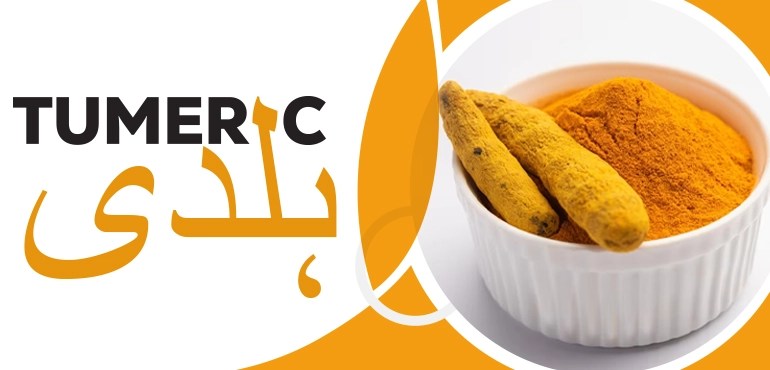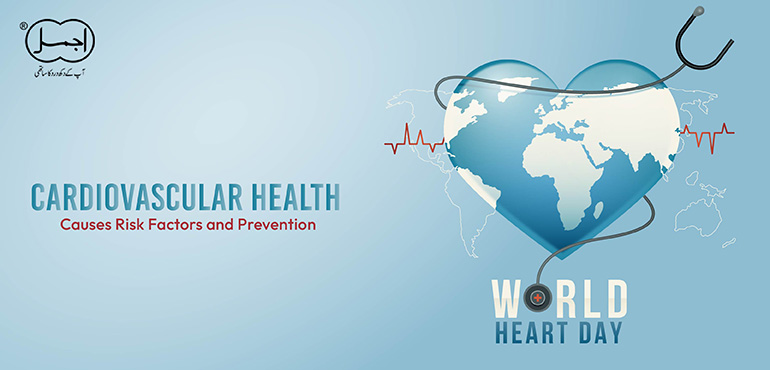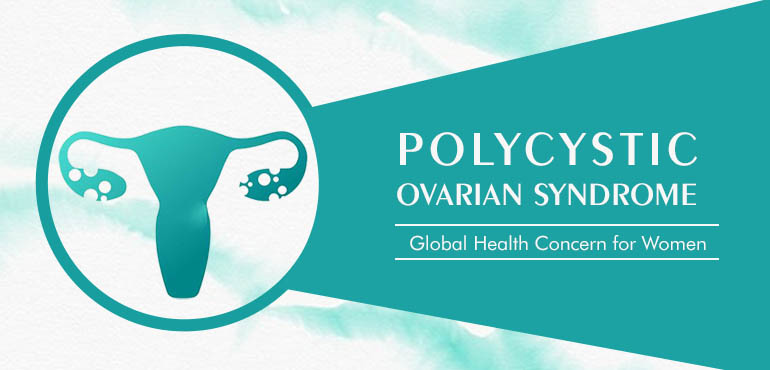The rhizome of this plant is a yellow-brownish herb called turmeric. Turmeric is widely used in food preparation in the Indo-Pak subcontinent and gives a distinct colour and flavour to the food, as a result of which it is also called the “Indian Saffron” or “The Golden Spice”.
Previously, turmeric has been used as a dye to colour the robes of priests and monks. In Asia, it has also been used in cosmetics to produce a golden tint. As its therapeutic effects were discovered, turmeric also became an important part of ayurvedic medicine.
Currently, it is used to enhance the flavour of food in India, drank as a tea in Japan, added to drinks in Korea, used by cosmetic companies in Thailand, and added as a preservative and colouring agent in the United State
Turmeric Spice
A mature turmeric rhizome has a dull yellow-brownish colour. It is about 1-3 inches in length and 1 inch in diameter. India is the biggest exporter of turmeric herb and spice followed by China and a few other neighbouring countries.
To convert fresh turmeric into a powder or spice, boil it in water. After boiling for a few minutes, dry the boiled herb in a hot oven until it is completely dehydrated. Grind the dried herb until it is converted into a fine powder called turmeric spice. Drying turmeric increases its shelf life and makes it easier to be used for different purposes.
Phytochemistry
Turmeric is a complex product that contains hundreds of different components Approximately 100 compounds in turmeric have been isolated. The nutritional analysis shows that 100g of turmeric has the following components:
| Nutrients | Amount per 100g |
| Calories | 390kcal |
| Carbohydrates | 69.9g |
| Proteins | 8g |
| Fats | 10g |
| Dietary Fibre | 21g |
| Calcium | 0.2g |
| Sodium | 10mg |
| Iron | 47.5mg |
(Prasad and Aggarwal, 2011)
Turmeric is also a good source of essential fatty acids, ascorbic acid, and potassium.
The biochemical analysis of turmeric shows the presence of natural phenolic compounds, some of which are mentioned below:
- Curcuminoids
- Sesquiterpenoids
- Zingiberene
- Cinol
- Borneol
The characteristic yellow colour of turmeric is caused by curcuminoids whereas, its aroma is produced by the sesquiterpenoids. 94% of curcuminoid is composed of curcumin, the most biologically active component of turmeric.
Curcumin is a phenol responsible for imparting medicinal benefits to turmeric. It was first discovered by Vogel and Pelletier as the “yellow-colouring matter” (Jackson and Menke, 1881).
In 1910, the chemical structure of curcumin was identified and further studies began. By this time, turmeric has been used by health practitioners for centuries but the logic behind its medicinal properties was started to be scrutinised. These investigations concluded that curcumin has the ability to eliminate certain bacteria and can be used as an anti-bacterial agent (SCHRAUFSTÄTTER and BERNT, 1949).
Curcumin has also been shown to improve glucose tolerance in rats and can be used to manage Type 2 Diabetes. It can slow down cognitive impairment and protect against neurological disorders. Another promising result shown by curcumin is the management of cancer-induced symptoms like fatigue, nausea, and vomiting (Gupta et al., 2012).
Health Benefits
For centuries, turmeric has been used as a remedial herb in traditional medicines like Ayurveda medicine or Traditional Chinese Medicine. It has found its niche in Indian Traditional Medicine and is called the Rasayana herb. Rasayana is a branch of ayurveda medicine that specialises in longevity, anti-ageing, and improving mental faculties through the use of herbs and herbal products. In the past, turmeric was mostly used to eliminate bacterial infections, and for the treatment of respiratory diseases. The modern research done on turmeric reveals a greater spectrum of uses for turmeric which are discussed below:
- Anti-Ageing
Studies on ageing have revealed that high oxidative stress on the body increases the process of ageing. Two components of turmeric, curcumin and turmeric, are potent anti-oxidant. They provide the same protection against free radicals as vitamin E, an excellent anti-oxidant. This is the reason why turmeric has been used in different cosmetic products and is also used in homemade masks and facial products, especially in the Indo-Pak subcontinent (Cohly et al., 1998).

- Diabetes Mellitus (Ziabetus Shakari)
Type 2 Diabetes Mellitus (Ziabetus Shakari) is manifested by uncontrolled blood glucose levels. A product capable of managing glucose levels can be used for diabetes patients. Curcumin has been able to reduce glucose levels and HbA1C in diabetes patients. In addition to that, turmeric has also improved the function of the β-cells of the pancreas that produce insulin to normalise blood glucose levels.
Although adequate research is required before turmeric can be commercially used to treat diabetes patients, it has the potential to act as a natural alternative for insulin administration and other drugs (Pivari et al., 2019).

- Hyperlipidemia
Modern technology has made our lifestyle sedentary while increasing the intake of processed, high-calorie food. These dietary choices result in abnormal cholesterol levels and high lipid levels causing poor heart health. With the increased prevalence of heart issues, scientists are working to determine the efficiency of turmeric as it is said to be anti-hyperlipidemic. Curcumin in turmeric follows the same mechanism as statins (lipid-lowering drugs). It can lower triglyceride levels (TG), and low-density lipoprotein (LDL) (Panahi et al., 2017).
An interesting revelation in the use of hyperlipidemia is that a low dose of curcumin had a higher impact on cholesterol and lipoprotein levels, whereas a moderate dose of curcumin was more efficient in reducing the elevated levels of triglycerides (Alwi et al., 2008).

- Arthritis (Waja-ul-Mafasil)
Curcumin is a strong anti-inflammatory compound as evidenced by the decrease in the C-reactive protein. This property of curcumin is used for improving the bone and joint health of arthritis (Waja-ul-Mafasil) patients. However, more information is required in order to determine the exact dosage, upper toxic limit, adverse effects, and therapeutic limit of turmeric for bone health (Manzoni et al., 2020).

- Heart health
As stated above, curcumin has the ability to reduce the serum levels of triglycerides and lipoprotein which can improve heart health. Curcumin is a potent scavenger of free oxygen radicals and protects the structure of the heart by reducing oxidative stress on cardiac cells
(Ren et al., 2020).
Calcium is vital for the contraction of cardiac muscles. Curcumin stimulates the flow of calcium ions to cardiac cells and triggers the function of calcium channels which improves the integrity of heart muscles preventing the risk of heart failure.

- Cancer (Sartan)
Cancer (Sartan) is one of the leading causes of death, responsible for killing millions around the world. Naturally, scientists around the world are interested in determining the methods of treatment. The role of turmeric or curcumin in the prevention and treatment of cancer has been extensively studied. Curcumin works by reducing the rate of cell proliferation and inducing apoptosis in cancerous cells. It also reduces the biomarkers of cancer and alleviates the symptoms associated with cancer (Gupta et al., 2012).

Several studies are being done in order to determine the efficacy of curcumin for pancreatic cancer and prostate cancer. Although curcumin has reduced the proliferation rate of cancer cells, the determination of accurate doses and adverse effects is necessary before large-scale trials can be done.
However, the role of curcumin in the treatment of lung cancer has been well-established. A slower rate of proliferation and metastasis and enhanced apoptosis has been seen in cancer patients after the ingestion of turmeric (Wan Mohd Tajuddin et al., 2019).
- Mental Health Issues (Amraze Nafsaniya)
Neurological disorders are physical, electrical, and biochemical alterations in the brain or spinal cord resulting in disturbed nerve transmission.
The most commonly discussed mental health issue is depression, and herbalists are working to manage its expanding rates. The tests conducted on turmeric revealed that curcumin at high doses stimulates the secretion of ‘happy hormones’ dopamine and serotonin (Kulkarni, Bhutani and Bishnoi, 2008).

Alzheimer’s disease is a degenerative disease resulting from the loss of cognitive function. Curcumin is a strong antioxidant and anti-inflammatory compound that prevents lipid peroxidation which causes neurotoxicity in the AD brain (Baum and Ng, 2004).
Stroke is a serious nervous system disorder that occurs when an obstruction blocks the blood supply to the brain or part of the brain. Curcumin provides dietary protection to vessels and the vascular system and reduces the risk of stroke in patients (Kalani et al., 2014).
- Obesity (Saman-e- Mufrat)
Obesity (Saman-e- Mufrat) is a chronic disease that occurs when the weight of a person is too high compared to the height of that person. Obesity is a complex condition due to several inflammatory and oxidative issues present in the body. Curcumin reduces the oxidative load on the body and prevents the maturation of fat cells.

It also reduces the pro-inflammatory components produced by the adipose (fat) cells and reduces the inflammation in the body. This reduces the systematic weight gain occurring in the body due to constant inflammatory signalling.
As the inflammatory signalling is prevented the systematic deposition of fat cells is reduced and weight gain is controlled (Bradford, 2013).
- Turmeric for Skin
Turmeric also provides benefits to the skin, and is used in homemade facial masks, skin creams, and other cosmetics. It has been used as a home remedy for skin rashes, acne (Basoor-e- Labniya), and psoriasis (Taqashshure Jild). It has also been used as a colouring agent, and for the production of perfumes.
A few studies have determined the efficiency of turmeric in curing psoriasis, acne, and dermatitis (Nar Farsi) (Vaughn, Branum and Sivamani, 2016).

Numerous studies have revealed curcumin as an alternative treatment for various skin diseases (Vollono et al., 2019), but further trials are necessary to determine the accurate dose, mechanism of action of curcumin, and associated adverse effects of turmeric.
- Turmeric for Hair
Turmeric is also the main ingredient in DIY hair masks, hair gels, and other hair products. Benefits of turmeric for hair include protection of scalp health that lessens dandruff, prevents hair loss, and controls the production of oil. Besides introducing turmeric in hair products it can be consumed in the form of dietary supplements. Further studies are yet to reveal the difference in the efficiency of turmeric consumed through dietary and topical routes.

- Wound (Jarahat) healing
Besides restoring the functions of vital organs, curcumin also possesses the ability to heal superficial cuts. It stimulates the production of tissue factors boosting the rate of tissue restoration, tissue reformation, and collagen deposition (Tejada et al., 2016, Akbik et al., 2014).
If you wish to apply turmeric to a wound, add a small amount of turmeric spice into warm water and mix until a smooth paste is formed. Administer the paste on the wound until it is healed.

- Anti-microbial Agent (Daf-e-Taaffun)
The ability of turmeric to fasten the healing process is also accompanied by its ability to prevent the growth of microbes like viral, fungal, and bacterial agents. Curcumin destroys the DNA and damages the cellular membranes of bacteria. They also reduce their mobility and influence the multiplication and division of bacterial cells (Kaur et al., 2010).
Apart from its action against bacteria, turmeric along with several other spices is also efficient against fungal pathogens (Radwan et al., 2014).

Bioavailability of Turmeric
The data written above clearly shows that turmeric has a huge therapeutic potential. However, to take full advantage of the functions provided by turmeric, proper dosage, and potency should be determined.
The clinical trials conducted on different patients have demonstrated that curcumin is poorly absorbed. When curcumin was ingested alone moderate serum levels were achieved. The herbalists realized that in order to increase the bioavailability of curcumin turmeric should be consumed with black pepper. Peperine is the biologically active compound of black pepper and is responsible for increasing the absorption of curcumin. When turmeric and black pepper were ingested together a decent increase in serum levels while a decline in the clearance rate of curcumin was observed (G et al., 1998).
Tolerable Upper Limit (UL) of Turmeric
The use of turmeric is generally safe, and is frequent in the Indo-Pak population where almost all of the food consumed contains turmeric. World Health Organization (WHO), has determined the acceptable daily intake of turmeric to be:
1.4 mg per pound or 0-3 mg per kg body weight
However, caution is still warranted if consumed in large doses, especially for therapeutic purposes. Doses higher than this range can cause adverse effects most of which are not completely understood. Some studies have revealed the occurrence of iron deficiency anaemia due to the high dosage of turmeric. Moreover, it can also interact with the medications of diabetes patients further lowering blood glucose levels and provoking hypoglycemia.
Safety measures should be taken by the following population:
- Pregnant (Tadbeer-e-Hamla) and Lactating women
- Renal patients (Zauf-e-Kulliya)
- Liver patients (Talayyuf-e- Kabid)
Diabetics (Ziabetus Shakari)
Side Effects of Turmeric
Although, usually safe for healthy population turmeric can cause several adverse effects on health. These effects of the high dose of turmeric are usually associated with the presence of other morbidities, or interaction with medications. A few unwanted effects of turmeric are discussed below:
- Iron Deficiency Anemia (Faqr-ud-Dam)
Depending on the dose of turmeric, the absorption of iron is reduced by 20-90% (Tuntipopipat et al., 2009).
When turmeric is ingested with iron, it binds with ferric iron converting it into an insoluble complex. The insoluble iron remains in the gut and is eliminated from the body. The long-term intake of iron with turmeric lowers serum ferrous levels and results in iron deficiency anaemia (Smith and Ashar, 2019).
- Heavy Metal Intake
More than 30 years ago, the polishing of turmeric powder with lead and chromium started. By polishing with lead, the producers were able to sell their low-quality product with higher profits as it produced a brighter yellow colour preferred by the consumers. The intake of adulterated turmeric led to the build-up of heavy metals in the body causing poor overall health (Forsyth et al., 2019).
Long-term exposure to heavy metals like lead and chromium has serious harmful effects including high blood pressure, cytotoxicity, neurotoxicity, atherosclerosis, and cardiovascular mortality (Balali-Mood et al., 2021).
- Interaction with Medications
Apart from nutrients, turmeric also interacts with medications taken for different disorders. The most thoroughly analysed interaction of turmeric is with diabetes medicines. As discussed above, turmeric is capable of reducing blood glucose levels either by improving the function of insulin-producing cells of the pancreas or by stimulating the signalling pathways. If anti-diabetes medications are taken with turmeric they will perform their respective functions bringing down the overall serum glucose levels below the optimal range.
Other than diabetes medication, turmeric should also be avoided by patients on blood thinning medications. If turmeric is taken with warfarin, an anticoagulant, it can result in bleeding and bruising.
Conclusion
Turmeric herb is a natural supplement with a broad spectrum of uses in food, cosmetics, hair, and medicine. Mostly turmeric has been used as a spice to impart flavour and colour to food. The benefits of turmeric for the face and skin have been known for a long period of time as highlighted by its use in homemade beauty products for years. Curcumin is a robust anti-oxidant and anti-inflammatory constituent of turmeric, making it a strong herbal remedy for several diseases including diabetes, stroke, cancer, mental health issues, and arthritis. However, moderation should be the key when using turmeric for curative reasons otherwise severe harm can ensue.
Bibliography
- Prasad, S. and Aggarwal, B.B. (2011). Turmeric, the Golden Spice: From Traditional Medicine to Modern Medicine. 2nd ed.
- Jackson, C.L. and Menke, A.E. (1881). On Certain Substances Obtained from Turmeric. I. Curcumin. Proceedings of the American Academy of Arts and Sciences, 17, p.110.
- SCHRAUFSTÄTTER, E. and BERNT, H. (1949). Antibacterial Action of Curcumin and Related Compounds. Nature, 164(4167), pp.456–457.
- Gupta, S.C., Patchva, S., Koh, W. and Aggarwal, B.B. (2012). Discovery of curcumin, a component of golden spice, and its miraculous biological activities. Clinical and Experimental Pharmacology and Physiology, 39(3), pp.283–299.
- Cohly, H.H.P., Taylor, A., Angel, M.F. and Salahudeen, A.K. (1998). Effect of Turmeric, Turmerin and Curcumin on H2O2-Induced Renal Epithelial (LLC-PK1) Cell Injury. Free Radical Biology and Medicine, 24(1), pp.49–54.
- Pivari, F., Mingione, A., Brasacchio, C. and Soldati, L. (2019). Curcumin and Type 2 Diabetes Mellitus: Prevention and Treatment. Nutrients, 11(8), p.1837
- Panahi, Y., Ahmadi, Y., Teymouri, M., Johnston, T.P. and Sahebkar, A. (2017). Curcumin as a potential candidate for treating hyperlipidemia: A review of cellular and metabolic mechanisms. Journal of Cellular Physiology, 233(1), pp.141–152.
- Alwi, I., Santoso, T., Suyono, S., Sutrisna, B., Suyatna, F.D., Kresno, S.B. and Ernie, S. (2008). The effect of curcumin on lipid level in patients with acute coronary syndrome. Acta Medica Indonesiana, 40(4), pp.201–210.
- Manzoni, A.G., Passos, D.F., Leitemperger, J.W., Storck, T.R., Doleski, P.H., Jantsch, M.H., Loro, V.L. and Leal, D.B.R. (2020). Hyperlipidemia-induced lipotoxicity and immune activation in rats are prevented by curcumin and rutin. International Immunopharmacology, 81, p.106217.
- Ren, B.-C., Zhang, Y.-F., Liu, S.-S., Cheng, X.-J., Yang, X., Cui, X.-G., Zhao, X.-R., Zhao, H., Hao, M.-F., Li, M.-D., Tie, Y.-Y., Qu, L. and Li, X.-Y. (2020). Curcumin alleviates oxidative stress and inhibits apoptosis in diabetic cardiomyopathy via Sirt1-Foxo1 and PI3K-Akt signalling pathways. Journal of Cellular and Molecular Medicine, 24(21), pp.12355–12367.
- Gupta, S.C., Patchva, S., Koh, W. and Aggarwal, B.B. (2012). Discovery of curcumin, a component of golden spice, and its miraculous biological activities. Clinical and Experimental Pharmacology and Physiology, 39(3), pp.283–299.
- Wan Mohd Tajuddin, W.N.B., Lajis, N.H., Abas, F., Othman, I. and Naidu, R. (2019). Mechanistic Understanding of Curcumin’s Therapeutic Effects in Lung Cancer. Nutrients, 11(12), p.2989
- Kulkarni, S.K., Bhutani, M.K. and Bishnoi, M. (2008). Antidepressant activity of curcumin: involvement of serotonin and dopamine system. Psychopharmacology, 201(3), pp.435–442.
- Baum, L. and Ng, A. (2004). Curcumin interaction with copper and iron suggests one possible mechanism of action in Alzheimer’s disease animal models. Journal of Alzheimer’s Disease, 6(4), pp.367–377.
- Kalani, A., Kamat, P.K., Kalani, K. and Tyagi, N. (2014). Epigenetic impact of curcumin on stroke prevention. Metabolic Brain Disease, 30(2), pp.427–435.
- Bradford, P.G. (2013). Curcumin and obesity. BioFactors (Oxford, England), 39(1), pp.78–87.
- Vaughn, A.R., Branum, A. and Sivamani, R.K. (2016). Effects of Turmeric (Curcuma longa) on Skin Health: A Systematic Review of the Clinical Evidence. Phytotherapy Research, 30(8), pp.1243–1264.
- Vollono, L., Falconi, M., Gaziano, R., Iacovelli, F., Dika, E., Terracciano, C., Bianchi, L. and Campione, E. (2019). Potential of Curcumin in Skin Disorders. Nutrients, 11(9).
- Tejada, S., Manayi, A., Daglia, M., F. Nabavi, S., Sureda, A., Hajheydari, Z., Gortzi, O., Pazoki-Toroudi, H. and M. Nabavi, S. (2016). Wound Healing Effects of Curcumin: A Short Review. Current Pharmaceutical Biotechnology, 17(11), pp.1002–1007.
- Akbik, D., Ghadiri, M., Chrzanowski, W. and Rohanizadeh, R. (2014). Curcumin as a wound healing agent. Life Sciences, 116(1), pp.1–7.
- Kaur, S., Modi, N.H., Panda, D. and Roy, N. (2010). Probing the binding site of curcumin in Escherichia coli and Bacillus subtilis FtsZ – A structural insight to unveil antibacterial activity of curcumin. European Journal of Medicinal Chemistry, 45(9), pp.4209–4214.
- Radwan, M.M., Tabanca, N., Wedge, D.E., Tarawneh, A.H. and Cutler, S.J. (2014). Antifungal compounds from turmeric and nutmeg with activity against plant pathogens. Fitoterapia, 99, pp.341–346.
- G, S., D, J., T, J., M, M., R, R. and Ps, S. (1998). Influence of Piperine on the Pharmacokinetics of Curcumin in Animals and Human Volunteers.
- Tuntipopipat, S., Zeder, C., Siriprapa, P. and Charoenkiatkul, S. (2009). Inhibitory effects of spices and herbs on iron availability. International Journal of Food Sciences and Nutrition, 60(sup1), pp.43–55.
- Smith, T.J. and Ashar, B.H. (2019). Iron Deficiency Anemia Due to High-dose Turmeric.
- Forsyth, J.E., Nurunnahar, S., Islam, S.S., Baker, M., Yeasmin, D., Islam, M.S., Rahman, M., Fendorf, S., Ardoin, N.M., Winch, P.J. and Luby, S.P. (2019). Turmeric means ‘yellow’ in Bengali: Lead chromate pigments added to turmeric threaten public health across Bangladesh. Environmental Research, 179, p.108722.




